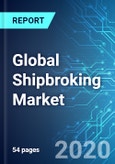Scope of the Report
The report entitled “Global Shipbroking Market: Size and Trends with Impact Analysis of COVID-19 (2020 Edition)” provides an analysis of the global shipbroking market with detailed qualitative analysis of the impact of COVID-19 on different segments within shipbroking. The report also includes an assessment of the market in terms of value and segment.
Clarkson Plc., A.P. Moller-Maersk Group and Braemar Plc. are some of the key players operating in the global shipbroking market, whose company profiling has been done in the report. In this segment of the report, business overview, financial overview and business strategies of the companies are provided.
Company Coverage:
- Clarkson Plc
- A.P. Moller-Maersk Group
- Braemar Plc
Table of Contents
1. Executive Summary
2. Introduction
2.1 Shipping: An Overview
2.2 Chartering: An Overview
2.2.1 Voyage Chartering
2.2.2 Time Chartering
2.2.3 Bareboat Chartering
2.2.4 Demise Chartering
2.3 Shipbroking: An Overview
2.3.1 Sales & Purchase (S&P) Brokers
2.3.2 Bulkers Brokers
2.3.3 Tanker Brokers
2.3.4 Container Brokers
3. Global Market Analysis
3.1 Global Shipbroking Market: An Analysis
3.1.1 Global Shipbroking Market by Value
3.1.2 Global Shipbroking Market by Segments (Bulkers, Tankers, Sale & Purchase and Others)
3.2 Global Shipbroking Market: Segment Analysis
3.2.1 Global Bulkers Shipbroking Market by Value
3.2.2 Global Tankers Shipbroking Market by Value
3.2.3 Global Sale & Purchase Shipbroking Market by Value
3.3 Global Shipbroking Market Volume Analysis
3.3.1 Fleet Size by Principal Vessel Type
4. Impact of Covid-19
4.1 Impact on Global Shipbroking Market
4.1.1 Impact on Global Shipbroking Market Segments
4.1.2 Impact on Global Shipbroking Players
4.1.3 Increased Scope of Investment in Freight Technologies
5. Market Dynamics
5.1 Growth Drivers
5.1.1 Increasing Global Seaborne Trade
5.1.2 Accelerating Economic Growth
5.1.3 Rising Global Energy Consumption
5.1.4 Falling Oil Prices
5.2 Challenges
5.2.1 Environmental Protocols
5.2.2 Security Threats
5.2.3 Low Demand and Oversupply
5.3 Market Trends
5.3.1 Rise in Global Trade & Industrial Production
5.3.2 Digital Sensoring
5.3.3 Use of Renewable Resources
5.3.4 Green Shipping
5.3.5 Liquefied Natural Gas (LNG) As Fuel Alternative
6. Competitive Landscape
6.1 Financial Comparison of Global Shipbroking Market
7. Company Profiles
7.1 Clarkson Plc
7.1.1 Business Overview
7.1.2 Financial Overview
7.1.3 Business Strategy
7.2 A.P. Moller Maersk Group
7.2.1 Business Overview
7.2.2 Financial Overview
7.2.3 Business Strategy
7.3 Braemar Plc
7.3.1 Business Overview
7.3.2 Financial Overview
7.3.3 Business Strategy
List of Figures
Figure 1: Components of Shipping
Figure 2: Types Of Charters
Figure 3: Types of Shipbrokers
Figure 4: Global Shipbroking Market by Value; 2015-2020 (US$ Billion)
Figure 5: Global Shipbroking Market by Segments; 2019
Figure 6: Global Bulkers Shipbroking Market by Value, 2015-2020 (US$ Million)
Figure 7: Global Tankers Shipbroking Market by Value, 2015-2020 (US$ Million)
Figure 8: Global Sale & Purchase Shipbroking Market by Value, 2015-2020 (US$ Million)
Figure 9: Global GDP and GDP Growth Rate; 2012-2016 (US$ Trillion)
Figure 10: World Energy Consumption; 2012-2016 (Billion Tonnes Oil Equivalents)
Figure 11: Global Average Annual OPEC Crude Oil Prices; 2012-2016 (US$ Per Barrel)
Figure 12: Clarkson Plc. Revenue; 2015-2019 (US$ Million)
Figure 13: Clarkson Plc. Revenue by Segments; 2019
Figure 14: Clarkson Plc. Revenue by Region; 2019
Figure 15: A.P. Moller-Maersk Group Revenue; 2015-2019 (US$ Billion)
Figure 16: A.P. Moller-Maersk Group Revenue by Segments; 2019
Figure 17: A.P. Moller-Maersk Group Revenue by Region; 2019
Figure 18: Braemar Plc. Revenue; 2015-2019 (US$ Million)
Figure 19: Braemar Plc. Revenue by Segments; 2019
List of Tables
Table 1: World Fleet by Principal Vessel Type (Thousand deadweight tons)
Table 2: Impact of Covid-19 on Different Shipbroking Segments
Table 3: Global Shipping Fleet Development; 2012-2016 (Dead Weight Tonnage, DWT)
Table 4: Financial Comparison of the Players of Global Shipbroking Market; 2016/2017 (US$ Million/Billion)
Samples

LOADING...
Executive Summary
Shipping is characterized as the physical procedure of transferring a thing, commodities, merchandise goods and cargo from one place to another. The major components involved in shipping are Shipowners, Charterers and Shipbrokers.
Shipowners own the ship and provide for commercial use for their own profit. Charterers, a person or the company who hires the ship/vessel for use to transport cargo. There are different types of chartering named as Voyage Charter, Time Charter, Bareboat Charter and Demise Charter.
Shipbrokers, act as an intermediary between ship owners and ship charterers. The different categories of shipbrokers are sales & purchase brokers, bulkers brokers, tanker brokers and container brokers.
Shipbroking suggests a movement of ships/cargo which is an integral part of the global shipping industry. The shipbrokers part is to act as a middle people amongst shipowners and the charterers who utilize ships to transport payload, or amongst purchasers and venders of ships. The different types of shipbrokers are sales & purchase brokers, dry cargo brokers, tanker brokers and container brokers.
Over the last decade, the global shipbroking market was supported by various growth drivers, such as, increasing global seaborne trade, falling oil prices, accelerating economic growth, rising global energy consumption, etc.
The speedy spread of COVID-19 has had a major impact on global shipping markets. COVID-19 has led to reduced demand for goods from China. This, in turn, is having a cascading effect on shipping markets be it container ships or oil tankers. The recovery in the shipping sectors like dry bulk and containers would be entirely dependent on a recovery in global economic activity, post abatement of the COVID-19 outbreak, starting from China. However, as to when the COVID-19 impact would subside is difficult to predict as the crisis is still in an evolving stage.
Companies Mentioned
- A.P. Moller-Maersk Group
- Braemar Plc
- Clarkson Plc








